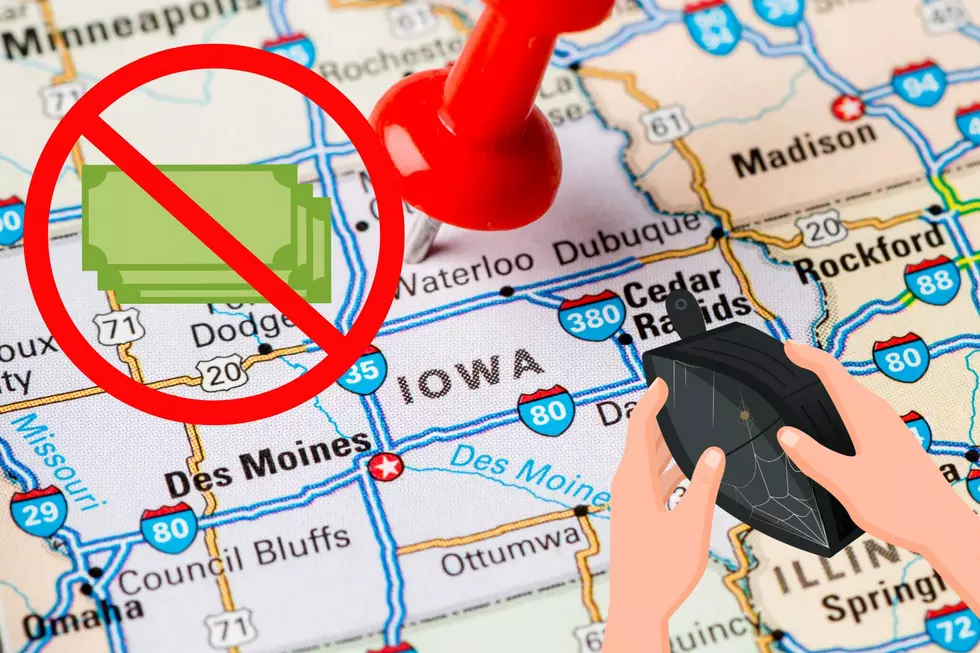![9 Of Iowa’s Worst Invasive Plants [PHOTOS]](http://townsquare.media/site/726/files/2023/06/attachment-Untitled-design-2023-06-23T110147.326.jpg?w=980&q=75)
9 Of Iowa’s Worst Invasive Plants [PHOTOS]
Before we dive into 9 of Iowa's worst invasive plants, what exactly is an invasive plant species? Are they that big of a deal and are they really that dangerous? According to the United States Department of Agriculture, an invasive plant species is a "non-native (or alien) to the ecosystem under consideration. The introduction causes or is likely to cause economic or environmental harm or harm to human health."
An invasive plant is something you'd rather not see growing around your house or in your neighborhood. They can threaten prairies, forests, and even aquatic areas. These invasive plants can heavily impact and damage the health of native plants and animals. Did you know most invasive species are normally introduced by humans, whether on purpose or by accident? At least according to Backyard Garden Lover, they are.
If we at least know how to identify these plants, we can take the necessary precautions and steps to control them. According to Backyard Garden Lover, these are 9 of the worst invasive plants in the state of Iowa.
9 Of Iowa's Worst Invasive Plants
Buckthorn
The buckthorn plant is a shrub or small tree which are originally introduced as hedges or landscape plants. The leaves have small edges and turn yellow in the fall and remain on the plant after most trees have dropped their leaves. In the spring, the berry drupes ripen and turn from red to black.
Burning Bush
Don't let the beautiful coloring of the burning bush distract you from the fact that this ornamental shrub is an invasive plant species in Iowa. The most effective control method is to cut this bush and apply herbicide to the stump, which will prevent the plant from resprouting.
Bush HoneySuckle
The honeysuckle shrub produces white/yellow flowers that have a sweet smell to them. These plants can form very dense thickets and have berries that ripen from orange or red. Small plants need to be pulled or dug, while larger plants need to be cut, and then apply herbicide to the stumps. Honeysuckles native to Iowa include the red honeysuckle and grape honeysuckle.
Garlic Mustard
This plant will grow heart-shaped leaves in its first year and in the second year, their flowering stalk can grow up to three feet tall. Thin, green seed pods follow and then the plants die in midsummer. If the plant is crushed, it will smell like garlic. If you can, hand pull and dispose of garlic mustard before it sets seeds.
Japanese Barberry
The Japanese barberry is a lower, dense shrub, which has a thorn that grows at the base of each cluster of leaves. These oval leaves are green and then turn purple/red in the fall. The best methods to take care of Japanese barberry are; prescribed burning, mowing, and cutting the stump.
Multiflora Rose
Here is another invasive plant species that may have a beautiful exterior but it is invasive in the state of Iowa. These shrubs can grow up to 15 feet tall and can be covered in thorny stems. Red rosehips can stay on the plant through the winter months. It is best to hand-pull, use foliar, or cut the stump and apply herbicide to control this plant. There are several roses native to Iowa including the prairie wild rose and early wild rose.
Oriental Bittersweet
The oriental bittersweet is a climbing vine that has glossy and round leaves attached. The easiest way to identify this invasive species is usually by the green or yellow fruits that break open to show 3 reddish arils, containing seeds. The best way to manage this plant is by mowing, spraying resprouts, or cutting the stump and applying herbicide.
Reed Canary Grass
Reed canary grass can grow anywhere from two to six feet tall. You can look for a stiff, half-inch ligule at the base of each leaf. They also will normally have three to six-inch branched flower clusters that are green, purple, or beige in color. You can hand-pull young plants in the spring before seeds form. You can also apply a foliar spray. Doing this consistently for multiple years in a row will be the most effective method of dealing with Reed Canary.
Tree Of Heaven
It was a bit tough to find an exact picture I could use on the "Tree of Heaven" so you got a video! This is a deciduous tree that can grow up to 80 feet tall. If the leaves from the Tree of Heaven are crushed or if the bark is scratched off, it will give off a very distinct and pungent odor. In the spring, small, yellow/green flowers will bloom at the end of the branches, followed by pink-winged fruits.
The best method to deal with the Tree of Heaven is to pull small seedlings and remove all root fragments. As always, you can also cut the stump and apply herbicide. Be sure to monitor each year for any resprouts.
These are 9 of the worst invasive plant species in Iowa, according to Backyard Garden Lover. Some of these invasive species may look beautiful and you may think they bring an improvement to your yard or garden. They don't. It's better to deal with these invasive plants sooner rather than later if they are on your property.
Iowa's Most Expensive Home is Light Years Beyond Ordinary
Exquisite 5,300 Square Foot Iowa Home For Sale
More From 94.1 KRNA
![Hold Up, Jumping Worms are Invading Iowa [VIDEOS]](http://townsquare.media/site/726/files/2022/04/attachment-Untitled-design-23.jpg?w=980&q=75)








